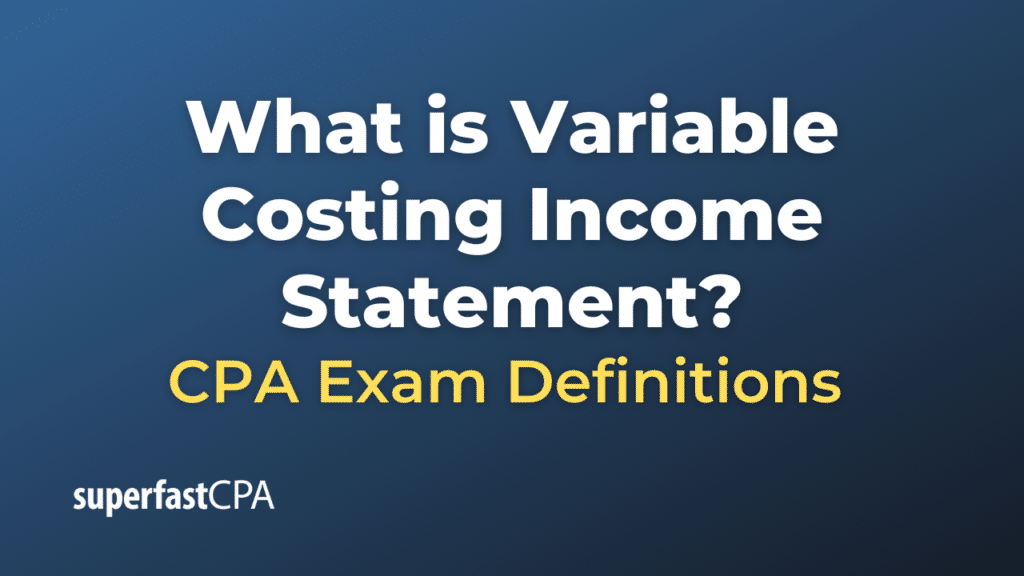Variable Costing Income Statement
A Variable Costing Income Statement is a type of income statement that segregates costs into variable and fixed categories. Unlike traditional income statements that allocate fixed overhead costs to products (absorption costing), a Variable Costing Income Statement treats all fixed costs as period expenses. This kind of income statement highlights the contribution margin, which is the revenue remaining per unit after covering variable costs.
Format:
Here’s a simplified format of a Variable Costing Income Statement:
GadgetPro Inc.
Income Statement (Variable Costing)
For the Month Ended March 31, 20XX
Revenues
Sales (Units Sold x Selling Price) $XXX,XXX
Cost of Goods Sold (COGS)
Variable Costs (Units Sold x Variable Cost Per Unit) $XX,XXX
Gross Margin (Contribution Margin) $XX,XXX
Operating Expenses
Fixed Manufacturing Overhead $X,XXX
Fixed Selling and Administrative Expenses $X,XXX
Total Fixed Costs $XX,XXX
Net Income $XX,XXXThe Variable Costing Income Statement offers a different perspective on a company’s cost structure and profitability, especially useful for internal analysis and short-term decision-making.
Example of Variable Costing Income Statement
Below is an example that builds on the fictional company “GadgetPro,” which manufactures wireless earbuds. This example shows what a Variable Costing Income Statement would look like for the month of March.
Assumptions for the Example:
- Selling Price per Unit of Earbuds: $60
- Variable Cost per Unit: $30 (Direct Material $15, Direct Labor $10, Variable Overhead $5)
- Units Produced: 2,000
- Units Sold: 1,800
- Fixed Manufacturing Overhead: $10,000 per month
- Fixed Selling and Administrative Expenses: $10,000 per month
Variable Costing Income Statement for GadgetPro (March 20XX):
-----------------------------------------------------------
GadgetPro Inc.
Income Statement (Variable Costing)
For the Month Ended March 31, 20XX
-----------------------------------------------------------
Revenues:
Sales (1,800 units x $60) $108,000
-----------------------------------------------------------
Variable Costs:
Cost of Goods Sold (1,800 units x $30) $54,000
-----------------------------------------------------------
Gross Margin (Contribution Margin) $54,000
-----------------------------------------------------------
Fixed Operating Expenses:
Fixed Manufacturing Overhead $10,000
Fixed Selling & Administrative Expenses $10,000
-----------------------------------------------------------
Total Fixed Operating Expenses $20,000
-----------------------------------------------------------
Net Income $34,000
-----------------------------------------------------------Analysis and Interpretation:
- Gross Margin: The Gross Margin of $54,000 is essentially the Contribution Margin. This is the amount left over after covering all variable production costs and can be used to cover the fixed expenses and contribute to net profit.
- Net Income : The Net Income for the month of March would be $34,000 after accounting for all fixed and variable expenses.
- Contribution per Unit : The contribution per unit would be the Selling Price per Unit ($60) less the Variable Cost per Unit ($30), which equals $30. This means each unit sold contributes $30 toward covering fixed expenses and earning profit.
- Break-even Point: With this information, the company can also calculate its break-even point in units, which would be the total fixed expenses ($20,000) divided by the contribution per unit ($30), equaling approximately 667 units.
The Variable Costing Income Statement is especially useful for internal decision-making related to pricing, production volume, and the analysis of operational efficiency. It clearly shows how much money is being made on an operational level before fixed costs are accounted for, providing valuable insights for management.













